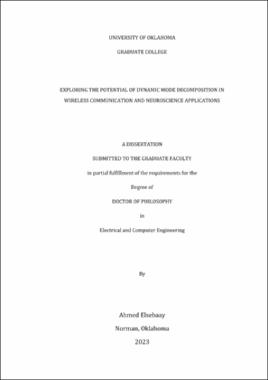| dc.description.abstract | The exponential growth of available experimental, simulation, and historical data from modern systems, including those typically considered divergent (e.g., Neuroscience procedures and wireless networks), has created a persistent need for effective data mining and analysis techniques. Most systems can be characterized as high-dimensional, dynamical, exhibiting rich multiscale phenomena in both space and time. Engineering studies of complex linear and non-linear dynamical systems are especially challenging, as the behavior of the system is often unknown and complex. Studying this problem of interest necessitates discovering and modeling the underlying evolving dynamics. In such cases, a simplified, predictive model of the flow evolution profile must be developed based on observations/measurements collected from the system. Consequently, data-driven algorithms have become an essential tool for modeling and analyzing complex systems characterized by high nonlinearity and dimensionality.
The field of data-driven modeling and analysis of complex systems is rapidly advancing. Associated investigations are poised to revolutionize the engineering, biomedical, and physical sciences. By applying modeling techniques, a complex system can be simplified using low-dimensional models with spatial-temporal structures described using system measurements. Such techniques enable complex system modeling without requiring knowledge of dynamic equations governing the system's operation.
The primary objective of the work detailed in this dissertation was characterizing, identifying, and predicting the behavior of systems under analysis. In particular, characterization and identification entailed finding patterns embedded in system data; prediction required evaluating system dynamics. The thesis of this work proposes the implementation of dynamic mode decomposition (DMD), which is a fully data-driven technique, to characterize dynamical systems from extracted measurements. DMD employs singular value decomposition (SVD), which reduces high-dimensional measurements collected from a system and computes eigenvalues and eigenvectors of a linear approximated model. In other words, by rather estimating the underlying dynamics within a system, DMD serves as a powerful tool for system characterization without requiring knowledge of the governing dynamical equations.
Overall, the work presented herein demonstrates the potential of DMD for analyzing and modeling complex systems in the emerging, synthesized field of wireless communication (i.e., wireless technology identification) and neuroscience (i.e., chemotherapy-induced peripheral neuropathy [CIPN] identification for cancer patients). In the former, a novel technique based on DMD was initially developed for wireless coexistence analysis. The scheme can differentiate various wireless technologies, including GSM and LTE signals in the cellular domain and IEEE802.11n, ac, and ax in the Wi-Fi domain, as well as Bluetooth and Zigbee in the personal wireless domain. By capturing embedded periodic features transmitted within the signal, the proposed DMD-based technique can identify a signal’s time domain signature. With regard to cancer neuroscience, a DMD-based scheme was developed to capture the pattern of plantar pressure variability due to the development of neuropathy resulting from neurotoxic chemotherapy treatment. The developed technique modeled gait pressure variations across multiple steps at three plantar regions, which characterized the development of CIPN in patients with uterine cancer.
Obtained results demonstrated that DMD can effectively model various systems and characterize system dynamics. Given the advantages of fast data processing, minimal required data preprocessing, and minimal required signal observation time intervals, DMD has proven to be a powerful tool for system analysis and modeling. | en_US |
